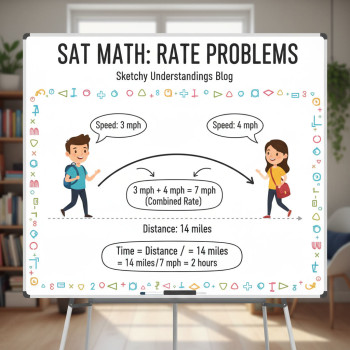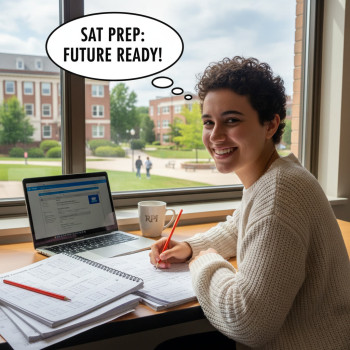Why Food Matters More Than You Think During SAT Prep
When your teen sits down for a practice test or a long evening of math and evidence-based reading, what they last ate can shape how well they think, focus, and recover. Nutrition isn’t just about growth or waistlines—it’s about the brain’s operating system. Steady energy, mood regulation, and clear thinking all depend on steady fuel and smart eating habits. As a parent, you can make a huge difference by shaping the food environment and habits that surround study time.

Big picture: What the brain needs during intense study
Think of the brain like a high-performance engine. For peak output it needs:
- Reliable, slow-burning energy (complex carbs and fiber)
- Protein to support neurotransmitters and lasting satiety
- Healthy fats for cell membranes and focus (omega-3s are especially helpful)
- Hydration to maintain processing speed and concentration
- Micronutrients—iron, B vitamins, vitamin D, magnesium—that support mood, memory, and energy metabolism
Short-term sugar spikes from candy or sugary drinks might seem to boost energy, but the crash that follows can make a student foggy during the most important parts of a study session—or worse, on test day.
How parents can encourage healthy eating without nagging
Shaping habits is mostly about environment, modeling, and gentle routines. Here are practical approaches that feel supportive rather than controlling.
1. Make nutritious choices easy and visible
- Stock the kitchen with ready-to-eat options: washed fruit, cut veggies with hummus, hard-boiled eggs, yogurt, mixed nuts, and whole-grain crackers. The easier it is to grab something healthy, the more likely your teen will choose it.
- Create a dedicated study-snack box. When study time starts, they can open the box and find pre-portioned, brain-friendly snacks—no decision fatigue.
2. Set predictable eating rhythms
Regular meals reduce the panic-grab syndrome. A simple schedule could look like:
- Balanced breakfast within an hour of waking
- A solid lunch with protein and fiber
- Planned study-session snacks (mid-afternoon and early evening)
- Light, satisfying dinner
Predictability prevents energy dips and helps teens regulate concentration across long study blocks.
3. Involve your teen in planning and prep
Autonomy matters. Invite your child to help make a weekly snack and meal plan. Offer choices (“Would you prefer trail mix or Greek yogurt with berries for study sessions?”) rather than directives. This builds buy-in and teaches planning skills they’ll use in college and beyond.
4. Keep hydration within reach
Dehydration—often subtle—reduces cognitive performance. Encourage a refillable water bottle and consider flavored water (a slice of lemon or cucumber) if plain water feels boring. Limit sugary sports drinks to occasions when there’s heavy exercise involved.
Snack strategies that actually support focus
Here’s a short cheatsheet for go-to snacks that combine convenience with nutritional value. Keep these in regular rotation:
- Greek yogurt with berries and a sprinkle of granola
- Apple slices with nut butter
- Hummus with carrot and cucumber sticks
- Whole-grain toast with mashed avocado and a pinch of salt
- Handful of mixed nuts and dried fruit (watch portion size)
- Hard-boiled eggs and cherry tomatoes
- Banana with a small scoop of peanut butter
Sample meal plan for a heavy study day
This example balances slow-burning carbs, protein, healthy fat, and hydrating elements. Use it as a template and adapt to your teen’s tastes.
| Time | Meal/Snack | Why it helps |
|---|---|---|
| 7:30 AM | Oatmeal with milk, sliced banana, and chia seeds | Complex carbs + protein + omega-3 precursor for steady energy |
| 10:30 AM | Greek yogurt with blueberries | Protein to support neurotransmitters and antioxidants for recovery |
| 1:00 PM | Grilled chicken salad with quinoa, mixed greens, and olive oil | Lean protein + whole grains + healthy fat for sustained focus |
| 3:30 PM | Snack box: apple slices, almond butter, whole-grain crackers | Fiber + protein to prevent afternoon slump |
| 6:30 PM | Salmon, brown rice, steamed broccoli | Omega-3s + complex carbs + vitamins for mood and memory |
| 8:30 PM (if studying) | Herbal tea and a small bowl of cherries or a square of dark chocolate | Light, satisfying, with antioxidants; avoid heavy meals that impair sleep |
Practical tips for test day nutrition
Test day is not the time to experiment. Follow these simple rules to minimize surprises.
- Eat a balanced breakfast: think protein + complex carbs + fruit. Example: scrambled eggs with whole-grain toast and an orange.
- Avoid heavy, greasy foods that slow you down or make you drowsy.
- Bring an allowed snack and water for breaks (check Digital SAT guidelines for permitted items). A nut-based snack or a banana plus water are usually safe choices.
- Stick to familiar foods—test day is not for trying trendy diets or new supplements.

Addressing picky eaters and limited appetites
Some teens resist hearty breakfasts or prefer grazing. If that sounds familiar, try these workarounds:
- Turn meals into smoothies or bowls so nutrient-dense foods are easier to consume (spinach, Greek yogurt, banana, peanut butter, and milk make a powerful smoothie).
- Offer small, frequent portions that add up rather than large plates they may avoid.
- Make food visually appealing—colorful fruit, fun containers, and variety help maintain interest.
Balancing energy, sleep, and study—how food fits into the puzzle
Healthy eating is only one piece of the SAT prep puzzle. Sleep hygiene and study strategies are equally important. Late-night study sessions fueled by energy drinks and chips often backfire: you trade short-term alertness for next-day fog. Encourage a rhythm where the body knows when to work and when to rest.
Practical routine example for a study evening:
- 4:30–6:00 PM: Focused study block with a light, protein-rich snack at the midpoint
- 6:00–7:00 PM: Family dinner—real food, conversation, and a break
- 7:30–8:30 PM: Low-stakes review (flashcards, light practice). Finish caffeine by early afternoon to protect sleep.
How study coaching and nutrition work together
Study habits and nutrition reinforce each other. When students have a predictable routine, tutors can tailor study plans more effectively. That’s where personalized tutoring—like Sparkl—can help. Sparkl’s 1-on-1 guidance and tailored study plans create predictable, focused study blocks. When tutors know a student’s peak study times, parents can align meals and snacks to those windows, maximizing concentration and knowledge retention.
Additionally, tutors can use AI-driven insights to spot when a student’s practice scores dip and recommend small routine tweaks—sometimes something as simple as a better pre-study meal or hydration strategy makes a measurable difference.
Simple grocery list for brain-boosting staples
Stocking the pantry and fridge with the right basics makes it easier for everyone in the family to make better choices.
- Whole grains: oats, brown rice, whole-grain bread, quinoa
- Lean proteins: eggs, chicken breast, canned tuna, Greek yogurt
- Healthy fats: olive oil, avocados, nuts, seeds
- Fruits & vegetables: berries, bananas, apples, leafy greens, carrots
- Hydration: water, herbal teas
- Convenience helpers: hummus, nut butters, pre-cut veggies
Quick recipes your teen can make
Encourage independence with simple, fast recipes they can prepare before a study block.
- Overnight oats: oats + milk + chia seeds + berries (prep night before)
- Egg and veggie scramble: eggs, spinach, tomatoes—ready in 6–8 minutes
- Yogurt parfait: Greek yogurt, granola, sliced fruit
- Avocado toast with a boiled egg
Mindful eating during prep: teach them to notice
Mindful eating helps students recognize genuine hunger versus boredom or stress. Encourage small rituals: a single deep breath before reaching for a snack, sitting down to eat without screens for a few minutes, and asking, “Am I hungry, or am I stressed about the practice test?”
What to do if your teen relies on caffeine or energy drinks
Many students lean on caffeine during crunch time. Rather than an abrupt ban, try these strategies:
- Gradually reduce reliance: swap one energy drink for green tea or a smaller coffee
- Pair caffeine with food to reduce jitteriness—avoid empty-calorie sugary mixes
- Set a cut-off time (e.g., no caffeine after 2 PM) to protect sleep
Remember: sleep and nutrition together matter far more for sustained cognition than a late-night energy burst.
Measuring success: small wins and signals to watch
Outcomes come slowly. Look for these signals rather than obsessing over a single score:
- Fewer afternoon energy crashes
- More consistent practice-test performance across multiple sessions
- Improved mood and willingness to study
- Better sleep quality and quicker morning starts
Real-world examples: a week in the life
Here’s a short, realistic outline of a family supporting SAT prep for a week. It shows small changes that compound into big benefits.
- Monday: Review the week’s study schedule with your teen; prep a snack box for afternoon sessions.
- Tuesday: Let your teen pick dinner one night to build autonomy; practice a timed math section in the evening after a high-protein snack.
- Wednesday: Midweek check-in—ask about energy levels; add a smoothie if mornings felt slow.
- Thursday: Practice essay or writing section after a light lunch; discuss test-day logistics.
- Friday: Lighter review and an engaging family dinner—social breaks reduce burnout.
- Weekend: Full practice test day—use the test-day meal plan and treat the day like the official experience.
When to seek professional advice
If your teen shows signs of unusual fatigue, dramatic weight change, persistent digestive issues, or anxiety that overwhelms their ability to study or sleep, consult a pediatrician or a registered dietitian. They can rule out medical causes and tailor nutrition advice, especially if your teen has dietary restrictions.
How parents can partner with tutors for nutrition-aware study plans
Open communication between parents and tutors can yield big wins. Share what you’ve observed about eating habits and energy patterns. A tutor—especially one using personalized approaches—can schedule high-focus tasks to match peak energy times, suggest low-intensity review periods during known dips, and remind students to take short, healthy snack breaks. Sparkl’s model of tailored study plans and 1-on-1 guidance fits naturally with this approach: when learning schedules and food strategies align, improvements tend to be steadier and more sustainable.
Wrapping up: small steps, big results
Encouraging healthy eating during SAT prep doesn’t mean overhauling everything overnight. Small, consistent steps—stocking the kitchen with brain-friendly foods, planning meals around study blocks, teaching mindful eating, and coordinating with tutors—create an environment where your teen can thrive. These changes boost stamina, sharpen focus, and reduce stress. Over time, they also build life skills your student will carry into college and beyond.
As a final thought: celebrate the process. Praise effort, small improvements, and the routines your family builds together. The Digital SAT is a milestone, but the habits formed during preparation—balanced eating, smart pacing, and partnership—are the real, lasting win.
If you’re curious about combining personalized tutoring with routine and nutrition planning, consider conversations that align study blocks with a student’s natural energy rhythms and dietary preferences—small alignments often produce disproportionately large results.

















No Comments
Leave a comment Cancel